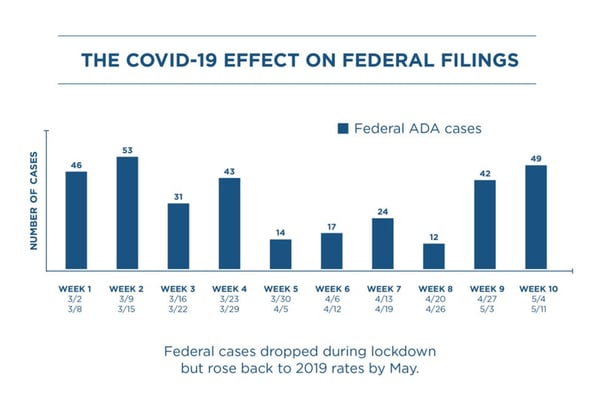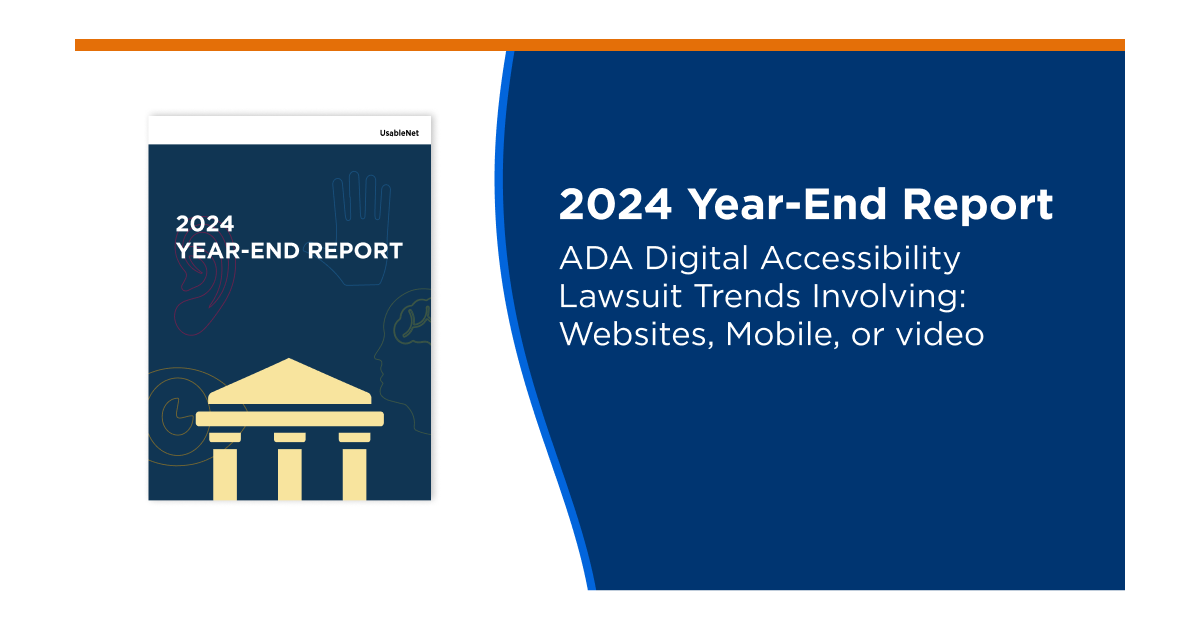2020 has thrown us all for a loop, and the world doesn’t look quite like it did a year ago today. It only makes sense that in the middle of a major societal overhaul that there might be some change to ADA and accessibility lawsuits during the pandemic.
That being said, trends in accessibility lawsuits may not have changed exactly how some businesses may have expected.
This post summarizes the main points from UsableNet's October webinar featuring presenter Jennifer Rusie, Shareholder at Ogletree Deakins.
How the Pandemic Has Impacted ADA Filings
The pandemic had a clear and direct impact on ADA filings, but only when lockdowns across the country were widely enacted.

As you can see in the graph above, federal filings of accessibility lawsuits dropped dramatically when stay at home orders and government-mandated shutdowns took effect in large parts of the country. Filings dropped from 43 filings in the fourth week to only 15 the next. As things reopened the last week of April, however, cases shot right back up and have held steady ever since.
Why ADA Filings Are Staying Strong During the Pandemic
When the ADA was first signed into law, it required businesses and organizations to grant equal access to all individuals regardless of disabilities. At the time, the internet wasn’t a household necessity like it is now, and the biggest focus was on physical access.
Now, though, that’s changed. Business’s online sites and mobile apps are often an integral part of the customer experience. That’s been true for the last decade, but it’s become even more true during COVID when everyone’s access to physical locations may be limited. We’re all relying more on online tools and shopping, and if your digital presence isn’t fully accessible, you could have an ADA lawsuit on your hands.
The State of Webb & App Legal Actions
As of right now, about 100 lawsuits per week are being filed for digital accessibility violations, typically citing either the ADA, Unruh, or FHA. Businesses in the retail, hospitality, and banking industries are currently receiving the most lawsuits, though 70% are filed in New York with about 5 plaintiff-side firms behind over 73% of these filings.
There’s been an increase in demand letters, and an increase in lawsuits for apps and sites that are using “accessibility” overlays.
Why Follow WCAG 2.1 for ADA ComplIance
The WCAG 2.1 is currently considered the standard for accessibility. They aren’t officially mandated by law, though this may change.
The Online Accessibility Act has been proposed in the House of Representatives to create a separate title IV of the ADA to address digital content. It would be applicable to consumer-facing websites and apps, and the US Access Board would oversee final standards.
The Online Accessibility Act would require that plaintiffs must give written notice requesting the company change the problems before filing a suit.
If the company doesn’t resolve the issue and is found to have violated the ADA, first-time offenders can be fined $20,000, and they can be fined $50,000 for every subsequent offense.
Types of Enforcement
Many of these lawsuits may be filed be the same plaintiffs who are considered "testers of compliance."
On the October UsableNet webinar, The state of ADA, gust speaker Jennifer Rusie, Shareholder at Ogletree Deakins at the time, spoke to some of the routes she has seen specific plaintiff lawyers take when pursuing accessibility claims for digital content.
In her experience, some firms will almost always send demand letters prior to filing a formal complaint. Other attorneys may threaten to file human rights complaint within the plaintiff’s state.
For website or app accessibility lawsuits where they are many of the same repeat players, it may be best to consult with outside counsel experienced in this area; they already have a lay of the land and can guide you.
Firms in New York, Miami, Pittsburg, and Southern California are the most common filers, and few file in other districts, though the state where the plaintiff lives is what matters when it comes to filing.
Quick Defenses to ADA Lawsuit Demands
In the following cases, you may be able to prevent an ADA lawsuit that’s been threatened:
- If the issue is only online and in nexus jurisdiction, which involves a failure to state a claim
- If the website is owned or operated by another entity
- There’s a lack of specificity to the claim
- There’s no specific harm that’s been alleged and injunctive relief won’t remedy anything
Keep in mind, however, that even if you’ve made it all the way through a suit and even paid a settlement to a single plaintiff, it doesn’t grant you any protection from additional future claims. The agreement is only good to the specific plaintiff who brought the lawsuit to you; you could easily be sued by other plaintiffs and attorneys.
Final Thoughts: What’s Next?
When you’re looking to reduce your legal risk for ADA lawsuits while you work on the remediation of your website, the following are solid first steps:
- Take stock of your existing websites and app
- Test all top pages for WCAG highly-visible issues that are auto-detectable with software; this is how many attorneys and plaintiffs find businesses to sue
- Hire a blind user to test your website, completing top tasks and flagging any issues
- Publish an accessibility statement and a link where someone can access help if needed
ADA lawsuits aren’t going anywhere, and businesses without fully accessible sites should take a proactive approach to accessibility, not just to avoid lawsuits but to ensure the best, most inclusive experience for customers of all abilities.
Take the time to make sure your digital presence is up to the task, and it will be well worth it in the long-run.











